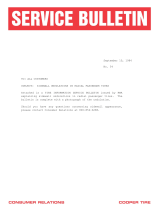
wc_si000848gb_FM10.fm
10
Safety Information PT 6L
1.2 Machine Description and Intended Use
This machine is a centrifugal trash pump. The Wacker Neuson Trash Pump
consists of a trailer with integral fuel tank onto which are mounted a diesel engine,
and an impeller pump with ports for water suction and discharge. The engine
rotates the impeller during operation. Waste water is drawn into the pump through
the suction port and expelled through the discharge port. The operator connects
hoses to the pump and routes them so that water and solids are drained from the
work area and discharged into an appropriate location.
This machine is intended to be used for general de-watering applications. This machine
is intended for the pumping of clear water, or water containing solids up to the size
stated within the product specifications; and up to the flow, head, and suction lift limits
also stated within the product specifications.
This machine has been designed and built strictly for the intended use described
above. Using the machine for any other purpose could permanently damage the
machine or seriously injure the operator or other persons in the area. Machine
damage caused by misuse is not covered under warranty.
The following are some examples of misuse:
■ Pumping flammable, explosive, or corrosive fluids
■ Pumping hot or volatile fluids that result in pump cavitation
■ Operating the pump outside of product specifications due to incorrect diameter
hoses, incorrect length hoses, other inlet or outlet restrictions, or excessive
suction lift or head
■ Using the machine as a ladder, support, or work surface
■ Using the machine to carry or transport passengers or equipment
■ Operating the machine outside of factory specifications
■ Operating the machine in a manner inconsistent with all warnings found on the
machine and in the Operator’s Manual
This machine has been designed and built in accordance with the latest global
safety standards. It has been carefully engineered to eliminate hazards as far as
practicable and to increase operator safety through protective guards and labeling.
However, some risks may remain even after protective measures have been taken.
They are called residual risks. On this machine, they may include exposure to:
■ Heat, noise, exhaust, and carbon monoxide from the engine
■ Fire hazards from improper refueling techniques
■ Fuel and its fumes
■ Personal injury from improperly lifting the trailer tongue
■ Projectile hazard from discharge
■ Crushing hazards from a tipping or falling pump (placing the vibrating pump on
an uneven surface or near the edge of a trench increases the risk of the pump
falling over)
■ Typical hazards related to towing a trailer on roads and highways






















